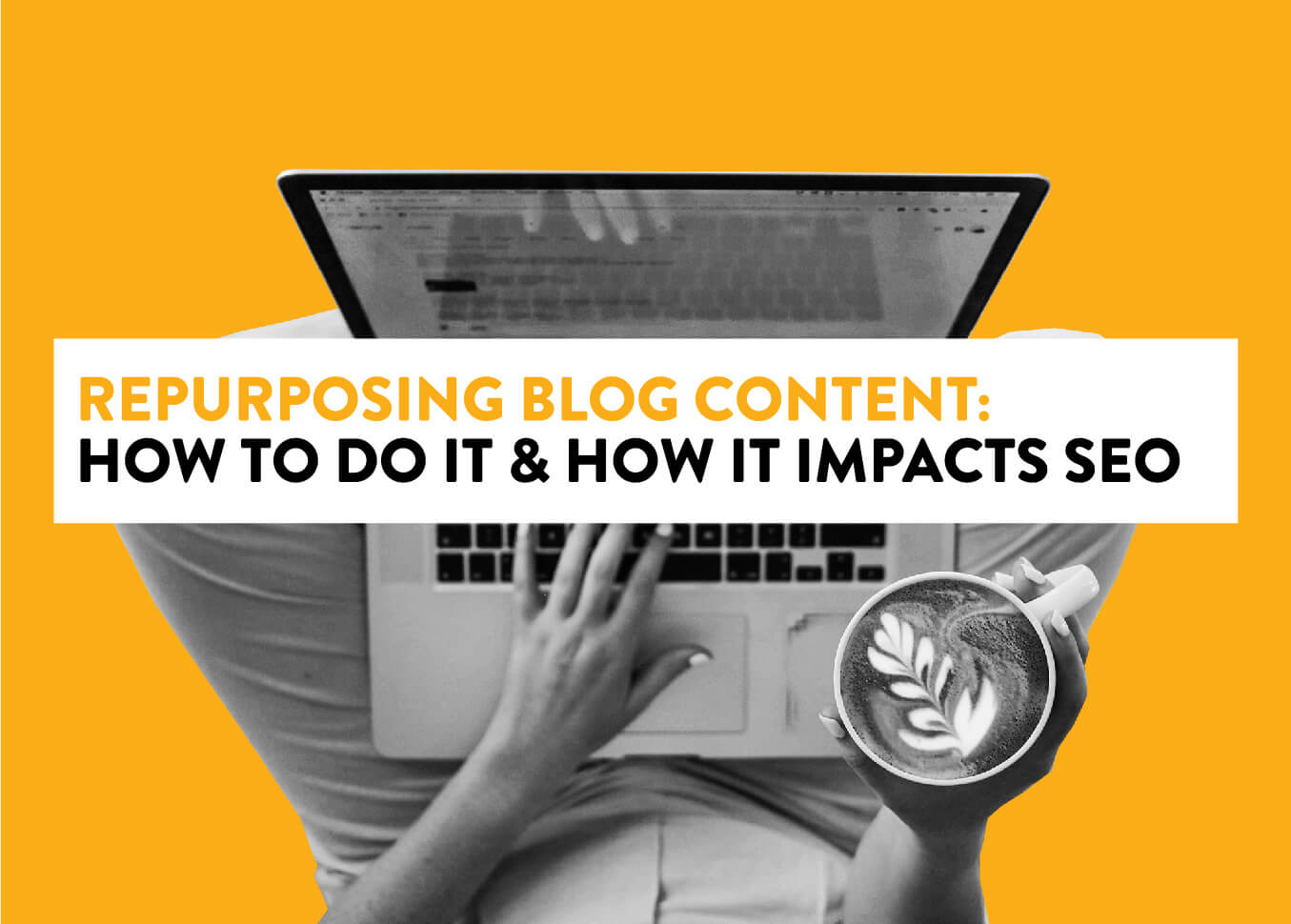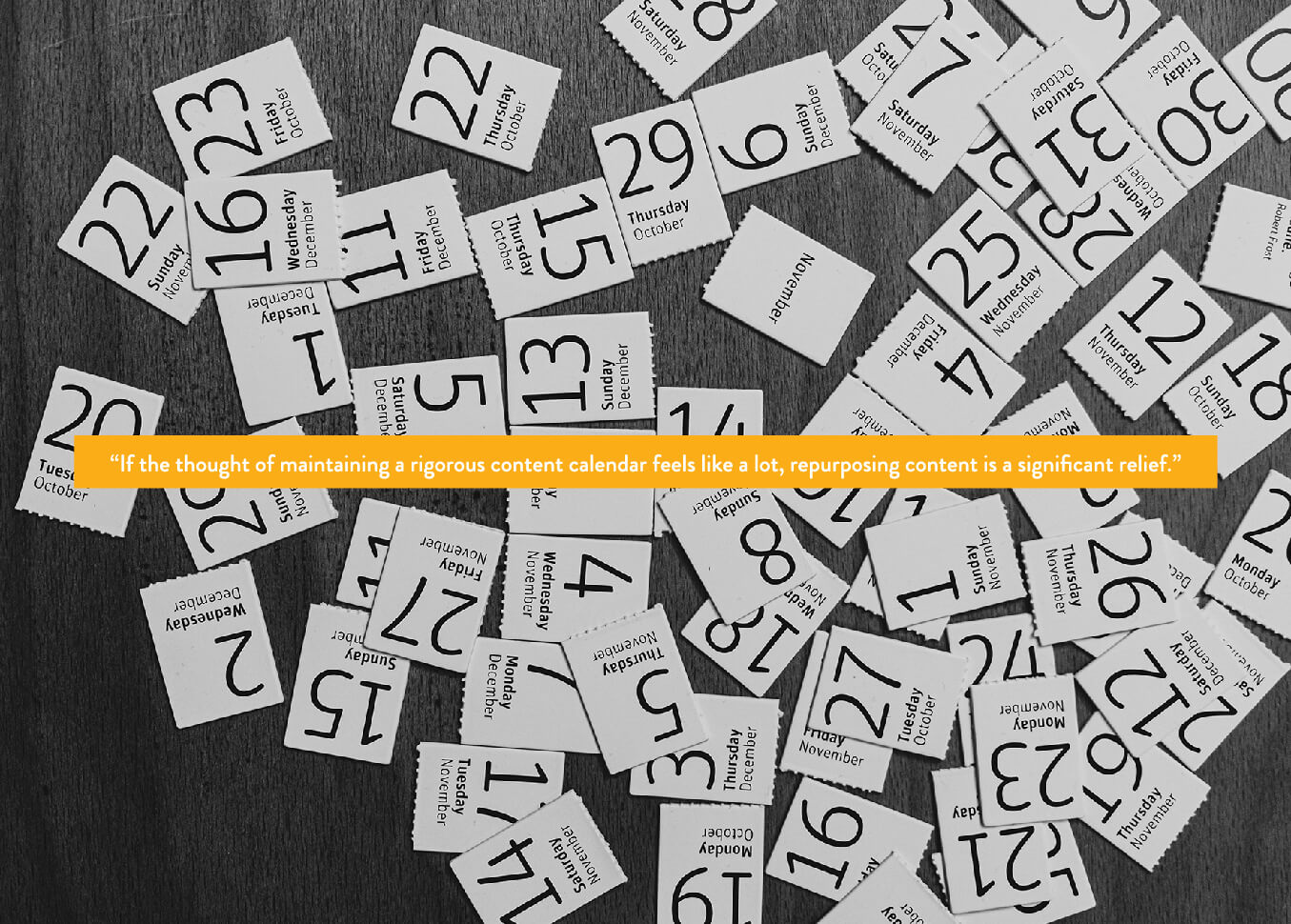
Repurposing content means creatively reusing existing blog content in new and innovative ways to extend its value and reach. Think of it like upcycling in the world of content creation. For example, a well-received blog post could be transformed into an engaging podcast episode, an eye-catching infographic, a downloadable, or a shareable social media post.
This helps businesses and individuals save time and resources and amplifies the visibility and longevity of the original content. Moreover, repurposing can play a significant role in enhancing your SEO. It presents numerous opportunities to boost your site's rankings, drive organic traffic, and increase your online authority.
Now, let's look at how you can successfully repurpose your blog content and how it might affect your SEO performance.
How To Repurpose Content

Repurposing content is a resourceful way to ensure you always have new, appealing material to offer your audience without depleting your reservoir of new topic ideas. This is especially helpful if your content piece has already garnered considerable views, as repurposing it can ensure you get even more out of a successful asset.
If the thought of maintaining a rigorous content calendar feels like a lot, repurposing content is a significant relief. By transforming a single piece of content into multiple formats, you can quickly populate your content schedule, ensuring you consistently deliver quality material to your audience.
So, let's talk more about the practical aspects of this strategy. How exactly can you repurpose your blog content? The possibilities are vast and depend on the type of content you have, the channels you use, and your audience's preferences.
Find Evergreen Pages
Like the evergreen trees that maintain their foliage all year round, evergreen content is a type that maintains its effectiveness for a long time. It can be relevant in any season and provides information or value to readers for an extended period without becoming outdated. This contrasts "seasonal" content that might be popular for a time but loses its relevance once the season or trend has passed.
The true value of evergreen content lies in its enduring nature. Given its timeless appeal, evergreen content continually attracts new visitors, leads, and potential customers to your site long after it was initially published.
Creating evergreen content involves:
- Creating topics that will always be relevant to your audience. These could be "how-to" guides, FAQs, industry principles, case studies, or listicles, to name a few. The key is providing information that is perpetually valuable and not tied to a specific event or trend.
- Using a style of writing that won't become outdated. Avoid industry-specific jargon or "trendy" words and use language that won't date your content.
- Performing regular audits to keep your content up-to-date. This could involve tweaking facts, changing old statistics with new ones, or updating the content's structure and formatting.
So, why is evergreen content great for repurposing? Here are a few reasons:
- Since evergreen content is always relevant, it can be repurposed repeatedly over a long period without becoming outdated.
- As evergreen content continues to draw traffic, it sends positive signals to search engines about your website's value, enhancing your SEO performance.
- Evergreen content tends to engage users consistently, making it a fantastic resource for generating new versions of content to engage different audience segments.
- Regularly updating and repurposing evergreen content reinforces your authority on a subject, building trust with your audience and potentially increasing conversions.
By identifying the evergreen content on your site, you can leverage it for repurposing, helping to maintain a vibrant and dynamic content strategy that continues to attract, engage, and convert visitors while supporting your SEO efforts.
Break Up Content Into Smaller Pieces
Another effective way to repurpose content is by breaking larger texts into smaller, more digestible snippets. This approach serves multiple purposes:
- It creates additional content that can be shared across different platforms, extending your original content's reach. An extensive blog post, for example, can be dissected into several shorter posts for platforms like LinkedIn or Twitter. These snippets can then drive traffic back to the original blog post.
- Breaking up content improves accessibility for your audience. Large blocks of text can be intimidating or difficult to read, especially for users with certain cognitive or visual impairments. By providing content in smaller, bite-sized pieces, you can make it easier for a wide range of users to engage with your content.
Here's how you can break up your content into smaller pieces:
- Pull out key points or facts from your larger content pieces to create standalone mini-posts or social media updates.
- If you have a particularly long blog post or an exhaustive guide, consider breaking it up into a series of shorter blog posts, each focusing on a different aspect of the topic.
- Turn the subheadings of your content into a listicle. For example, "5 Key Takeaways From Our Latest Whitepaper".
- Infographics are a great way to break up complex data or concepts into visually appealing, easy-to-understand snippets.
- Extract questions from your larger content and create individual Q&A posts for each one.
This way, you can make your content more palatable and accessible to your audience.
Turn Existing Content Into Visual Aids
Another excellent strategy for repurposing content is converting textual content into visual aids. This can include creating:
- Infographics
- Charts
- Diagrams
- Videos
- Slide presentations from your existing blog posts or articles.
Not only do these visual formats make complex information more understandable and engaging, but they also have profound effects on your SEO. Multimedia and rich media are increasingly vital in search engine optimization.
Here's how:
- Visual aids can significantly improve the UX of your site by making content more engaging and easier to digest. A positive user experience can decrease bounce rates and increase the time spent on your site — both important metrics for SEO.
- When search engine crawlers see rich media like videos or images on your site, it indicates that your site provides diverse content, which can positively impact your rankings.
- Visual content like infographics or videos are highly shareable, which can increase the number of backlinks to your site.
- Adding relevant visuals or graphics to supplement your keyword-rich content can lead to a boost in search traffic.
- By adding alt text to your images, you're describing your visual content to search engines and visually impaired readers. This strengthens keyword association, helps search engine algorithms contextualize your images with the rest of the page content, and improves your website's accessibility.
Not convinced? Consider this: 90% of information transmitted to the brain is visual. So, if you want to make an impression on your audience, using visual aids is the way to go.
Use Repurposed Content for Guest Posts
Guest posting is contributing content to another person's website or blog to build relationships, exposure, authority, and links. This method is a valuable tool for many reasons:
- When you guest post on a reputable site, you can place backlinks to your website within your contributed content. These backlinks help search engines determine the authority of your site.
- Guest posting helps you to reach a larger or different audience, which can drive new site traffic. This increased exposure can lead to a rise in brand recognition and potentially more conversions.
- Guest posting is a great way to build new relationships across your industry and niche.
So, how can repurposed content come into play for guest posts? Reworking or reformatting your existing content can provide valuable insights to a new audience without creating entirely new ideas.
Here are some tips for effective guest posting:
- Look for websites or blogs relevant to your industry with a good reputation.
- Include relevant backlinks to your site within the content, but don't overdo it.
- Every site has its own rules for guest posting — respect them.
- After your guest post is published, promote it on your channels to drive traffic.
While guest posting can be a powerful SEO tool, be wary of any practices that might harm your reputation or that of the host site. Avoid spammy tactics, don't overstuff your post with links, and ensure your content is always high-quality and relevant.
Optimize and Republish Existing Content
Content optimization means updating, improving, and enhancing existing content. It's a tactic focused on augmenting the effectiveness of your content, enabling it to rank higher in search engine results and ultimately driving more traffic to your website.
Where do you start? Consider these key steps to optimize and republish content:
- Check for accuracy and relevancy — Is the content still up-to-date? Does it accurately reflect your product or service offering?
- Revise and rewrite where necessary — Are there any sections of the content that could use extra clarity? Could you add more insights or examples?
- Include relevant keywords — Are you using the right target keywords? Remember that as search trends evolve, so should your keyword strategy.
- Improve formatting for readability — Are there any formatting issues that must be addressed?
- Ensure accessibility — Is your content compliant with ADA standards?
While these steps provide a good foundation for content optimization, investing in professional content marketing services can be incredibly beneficial. These experts have the resources and skills to optimize your content thoroughly, ensuring no stone is left unturned.
Why Is Repurposed Content Important for SEO?

If you're not convinced, consider what industry experts have to say:
- Updating and optimizing old content can significantly boost your organic traffic. A study by HubSpot found that "up to 76% of monthly blog views come from 'old' posts."
- As per Gary Vaynerchuk's content model, "One piece of 'pillar content' can be repurposed into dozens of smaller pieces of content, contextual to the platforms that we distribute them to."
So, there you have it — investing in repurposing your content is a smart, relatively easy, and cost-effective way to improve your website's SEO without doing too much.

